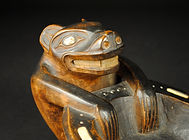The Jim and Vanita Oelschlager
Native American Ethnographic Collection
"Connecting Objects to their People: From the Arctic to Arizona"
Pacific Northwest: Land and People
The Northwest Coast cultures are defined by geography, old growth forests that rim the seacoast, and a dependence on the life cycle of the salmon. This natural abundance supported the development of complex and intertwining social relations, both within specific cultures and between cultural groups. The weather and resources combined to make these cultures the most affluent of all North American native groups and supported exceptional artistic expression, full of vibrant symbolism. Several language families are represented among the various tribes. The most noted tribes are the Tlingit, Tsimshian, Haida, Bella Bella, Bella Coola, Kwakiutl and Makah.
The northwest coastal cultural region runs along the Pacific coast, from Southeast Alaska to the northeast corner of California. The cultural region is one thousand five hundred miles long and does not exceed fifty miles in width. The Japanese Currents bring warm air to the coast, while the Cascade Mountains to the east block cold air from entering the area, both contributing to a temperate climate. The climate supports both deciduous and coniferous trees used for building materials, carvings, textiles, and energy. Plant and animal resources are abundant in the Northwest Coast cultural region, which allowed a large population of inhabitants to be sedentary even though they did not develop agriculture.
Natives depend on salmon as a primary food source, along with other species of fish. They also traditionally hunted whales, seals, and otters, as well as deer, elk, and fur-bearing mammals such as mink and beaver. They collected wild plants and berries to store in fish oil in carved cedar boxes for winter food.
The people of the Northwest Coast cultures have one of the great art styles of the world and one of the oldest in the Western Hemisphere. Due to unusual circumstances and materials, in several areas in the region artistic artifacts have been found that date from 400 BCE.
Very little occurred in the life of Northwest Coast peoples that did not include cedar. Cedar trees, both red and yellow, were the center of the culture’s utilitarian and artistic creations. Both the bark and trees were used extensively: they were the raw material for carved bowls, storage boxes, ceremonial masks, totem poles, woven baskets, clothing, and mats that covered the deceased. Cedar was always present in their lives in both weaving and carving.



